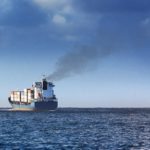Onboard Carbon capture & storage: a key solution for shipping’s complex decarbonisation challenge

For all the criticism and discussion around MEPC 80 this year, the IMO’s landmark environmental committee has given us one thing: the commitment to achieve net-zero emissions by around 2050 creates a clear sense of direction for an industry often criticised for its environmental impact.
However, let us be under no illusion that reaching these targets will be easy. Many will explore new, low carbon fuels and clean technologies. Optimising routes and speeds to operate vessels within optimal waters for efficiency will also become commonplace.
What may surprise many is the critical role that SOx scrubbers will end up playing as we work to cut shipping’s CO2 emissions. The exciting reality is that scrubbers currently installed in the global fleet can be adapted for onboard carbon capture and storage (CCS) in the near future. This futureproofing ensures these vessels are ready to capture an impressive 70% of carbon emissions from the exhaust.
The transition from addressing sulphur to carbon didn’t happen overnight. Over the past few years, scrubber capabilities have undergone successive upgrades to combat various pollutants in vessel emissions and throughout the propulsion chain. Selective catalytic reduction systems (SCR) and exhaust gas recirculation systems (EGR) have been employed to tackle NOx emissions, meeting MARPOL Tier III requirements. Moreover, these scrubbers can filter particulate matter and black carbon even beyond standard land-based regulations, and they are capable of removing microplastics from scrubber washwater through advanced filtering systems.

Benjamin A. Ward / Wärtsilä
To make CCS work within the confines of ship exhaust, all non-CO2 pollutants must be removed before the exhaust gas reaches the CCS system. Consequently, scrubbers have evolved from a technology aimed at reducing sulphur, NOx, and PM emissions for human health reasons into a versatile technology platform ready to address shipping’s holistic environmental challenges.
On the commercial front, scrubber adoption remains economically compelling. The stable price differential between high and low sulphur fuels ensures that the payback period for scrubber installations has reduced to less than two years for several vessel types. Additionally, as the cost of new, low-carbon alternative fuels remains high, the economic benefits of scrubbing are likely to endure for decades.

Wärtsilä Exhaust Treatment is presently testing its CCS system at a 70% CO2 capture rate at a shore-based test facility in Norway, with a pilot installation scheduled within the next 12 months. The technology has undergone rigorous testing, providing valuable insights into its operation and the pros and cons of various CO2 capture solvents.
Technology development is one aspect, but understanding how the technology needs to be incorporated onboard a vessel is another matter. The unique constraints of seaborne CCS, including space and energy requirements, storage infrastructure and exhaust pre-treatment all come into play. And we need to be able to solve these challenges for not just new ships, but for a wide range of existing vessels, if we are to be able to decarbonise.
Understanding and adapting to these challenges is why Wärtsilä has taken the next step in CCS development by offering the industry’s first CCS feasibility studies.
These in-depth studies involve a team of expert engineers dedicating four to six months to research and design work. The primary objective is to assist shipowners in understanding how to seamlessly integrate CCS technology into their vessels when it becomes available in the near future.

These CCS feasibility studies are conducted for both newbuild and existing vessels. Upon completion, they enable Wärtsilä to provide customers with a comprehensive commercial proposal that can be shared with shipyards to obtain precise installation quotations. The ultimate goal is to address most of the technical and naval architectural challenges associated with CCS adoption at the earliest possible stage.
To achieve this, our experts closely examine a ship’s existing naval architecture, exploring how to accommodate the power, space, and exhaust requirements of CCS onboard. Ship owners receive a detailed cost analysis for CCS integration, along with a transparent list of considerations for carrying out a potential retrofit with minimal disruption.
Conducting these studies today accelerates the initial phases of CCS integration. Additionally, these studies serve as an educational tool, helping customers understand the advantages and specific factors involved in installing CCS on their vessels. This represents a significant step towards bringing a CCS product to the market by 2025.
Our industry’s path to decarbonisation demands multiple solutions, and the evolution of scrubbers beyond sulphur, both in terms of technology and market perception, represents a crucial and necessary stride forward. So too does the continued effort to move from technology development to supporting technology adoption – first with feasibility studies, and soon with a pilot installation ahead of scaling a commercial offer.
The integration of scrubbers with CCS technologies signifies a decisive move towards achieving our net-zero goals and nurturing a greener future for shipping. This offers clear reason for optimism as we collectively strive to meet the IMO’s new environmental mandates.
Source: By Mr. Sigurd Jenssen, Director, Wärtsilä Exhaust Treatment
Source link
